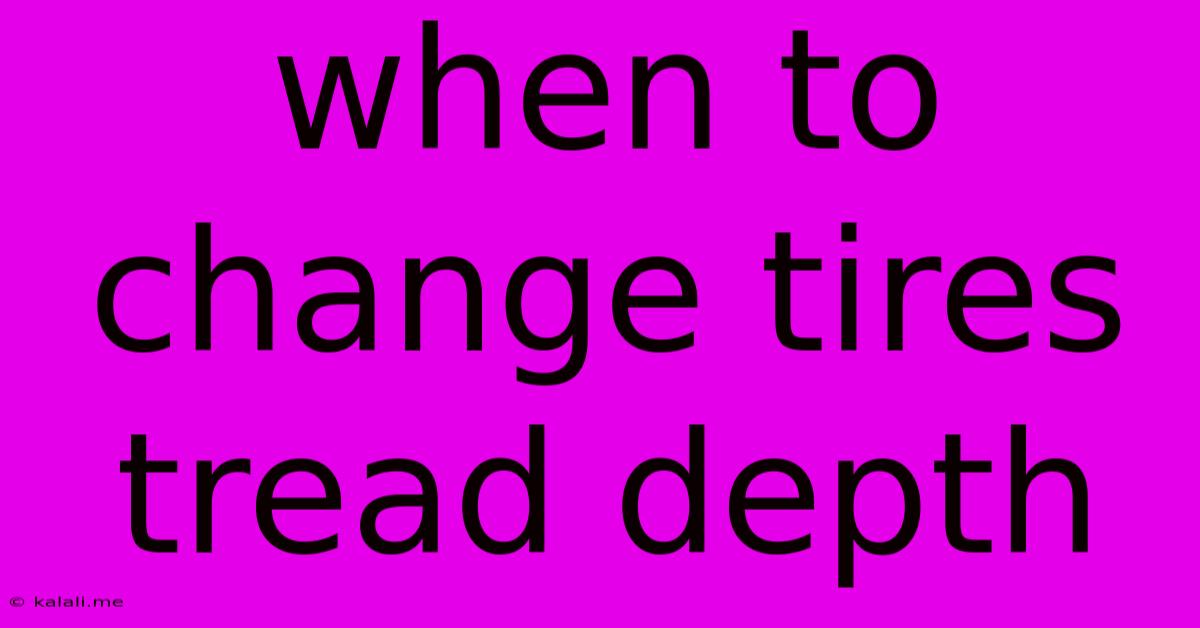When To Change Tires Tread Depth
Kalali
May 30, 2025 · 3 min read

Table of Contents
When to Change Your Tires: Understanding Tread Depth and Safety
Knowing when to change your tires is crucial for safety and optimal vehicle performance. This isn't just about aesthetics; worn tires significantly impact braking distance, handling, and overall control, especially in wet or icy conditions. The key indicator is tread depth, and understanding its importance is paramount. This article will guide you on determining when it's time to replace your tires, focusing on tread depth measurements and other vital factors.
The Importance of Adequate Tread Depth
Tire tread is designed with intricate grooves and channels to effectively disperse water, preventing hydroplaning and maintaining grip on the road surface. As tires wear down, the tread depth decreases, reducing this crucial functionality. Driving on tires with insufficient tread depth dramatically increases your risk of accidents. Reduced traction translates to longer braking distances, especially in adverse weather conditions like rain or snow. Poor handling and increased risk of skidding are also significant concerns.
Measuring Your Tire Tread Depth: The Penny Test and More
The simplest way to check your tire tread depth is the penny test. Insert a penny into the tread groove with Lincoln's head upside down. If you can see the top of his head, your tread depth is dangerously low, and you need to replace your tires immediately. This indicates a tread depth of less than 2/32 of an inch.
While the penny test is a quick visual check, for a more precise measurement, you can use a tire tread depth gauge. These inexpensive tools provide accurate readings in millimeters or 32nds of an inch. Checking the tread depth across multiple points on each tire is crucial, as wear can be uneven.
Beyond the Penny Test: Other Indicators of Tire Wear
While tread depth is the primary indicator, other signs warrant attention:
- Visible Wear Bars: Most tires have built-in wear bars—small raised indicators across the tread. When the tread wears down to the level of these bars, it's time for replacement.
- Uneven Wear: If you notice uneven wear patterns, such as one side wearing faster than the other, it suggests a potential alignment or suspension problem. Addressing the underlying issue is crucial before replacing tires, to prevent premature wear on a new set.
- Cracking or Damage: Cracks, bulges, or embedded objects in the tire sidewall indicate significant damage and require immediate replacement. These compromises the structural integrity of the tire, posing a serious safety risk.
- Age: Even if your tires have sufficient tread, their age also matters. Tires degrade over time due to UV exposure and general weathering. Most tire manufacturers recommend replacing tires after six years, regardless of tread depth. Check the date code (usually a four-digit number on the sidewall) to determine their age.
Optimal Tread Depth and Legal Requirements
While the penny test highlights dangerously low tread, most tire manufacturers recommend a minimum tread depth of 4/32 of an inch for optimal performance and safety. However, some jurisdictions may have legal minimums, usually around 2/32 of an inch. Check your local regulations for specific requirements.
Conclusion: Prioritize Safety
Replacing your tires at the appropriate time is not merely a matter of convenience; it's a critical safety measure. Regularly checking your tire tread depth using the penny test or a tread depth gauge, along with visual inspections for damage, helps ensure optimal vehicle handling and braking, significantly reducing the risk of accidents. Remember to factor in tire age and address any uneven wear patterns promptly. Prioritize safety and invest in new tires when necessary—it's an investment in your well-being and the safety of others.
Latest Posts
Latest Posts
-
How To Install Kitchen Sink Drain
May 31, 2025
-
Is Consciousness A Fundamental Nature Of Reality
May 31, 2025
-
Where Do Quicktime Screen Recordings Go
May 31, 2025
-
Eco Friendly Moss Killer For Roofs
May 31, 2025
-
Difference Between Equilibrium And Steady State
May 31, 2025
Related Post
Thank you for visiting our website which covers about When To Change Tires Tread Depth . We hope the information provided has been useful to you. Feel free to contact us if you have any questions or need further assistance. See you next time and don't miss to bookmark.